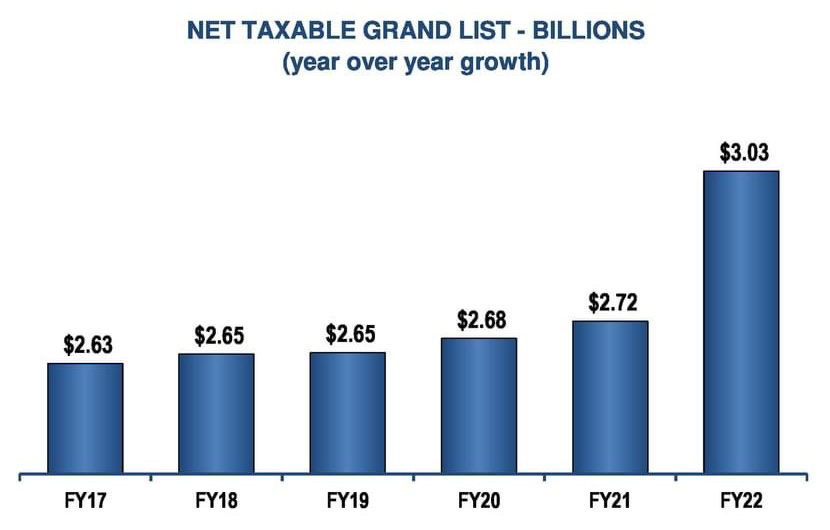The public will get its one and only chance to comment on Mayor Nancy N. Rossi’s proposed budget in a streamed public hearing slated for March 29 at 6 p.m. The City Council announced the hearing following last week’s special session in which the two-term mayor made public her fourth budget.
According to City Council Chairman Ronald Quagliani (D-at-large), the public can mail questions to City Hall (City Council Office, City Hall, 355 Main St.) or email them to the council’s office manager, Michael DiMassa (mdimassa@westhaven-ct.gov).
The total package comes in at $165.54 million for Fiscal Year 2022, which begins July 1. It is only a slight increase over the current budget, which totals $165.2. The Board of Education’s portion is $89,960,421. While the city operation clocks in at 75,582,280.

In comments made last week, the mayor promised to keep the city’s mill rate “constant.” The city was once again subject to revaluation of personal property and real estate, and the new figures raised the Grand List $312.5 million. The budget anticipates a personal property tax rate of 37 mills, while the real estate rate will drop to 34.
In the statement accompanying the publication of the budget, Rossi said the new infusion of cash allowed her to keep that promise.
“With the revaluation the city will move the mill rate downward to adjust for the significant increase in property values,” she wrote. “The fiscal year 2021 mill rate was 37.48, and I am recommending a reduced mill rate of 34.”
In her statements prior to the publication of the budget, Rossi said the city would refuse the last $2 million in state restructuring funds under the agreement set when the state took oversight of city spending in 2017. The Municipal Accountability Review Board (MARB) has been overseeing all city budgeting since 2017.That oversight is set to end in 2022, now that the city has produced three balanced budgets and three audits that show improvement.
She reiterated that plan in her budget message.
“I have removed the final year of MARB funding in the amount of $2 million from my recommended budget. It would be irresponsible to take this funding when our financial outlook is positive,” she wrote.
Meanwhile, money expected from the state is NOT included in the spending plan as presented because the state’s budget is not finalized. The budget debacle of 2016-17, which saw the state’s own budgetary process go on well passed Constitutional timelines saw anticipated money not come to the city, which prompted the shortfall leading to the state takeover.
Gov. Ned Lamont’s budget earmarks $4.972 million in stimulus money for the city and Payment-in-Lieu of Taxes (PILOT) funding given to cities and towns with tax-exempt institutions.
The recently passed “American Rescue Plan,” is set to send the city$18.76 million, half of which will be available within 60 days. The mayor only counted only $1.575 million of this in the budget. Meanwhile, the Board of Education is earmarked to get more than $20 million from the ARP for COVID-19 relief.
“Much of this new funding is one-time and non-recurring revenue and should not fund ongoing municipal operations or permanent expansion of programs” she wrote.
In speaking on the budget process, Chairman Quagliani noted the streamed meeting will be available at the time of the meeting and for later viewing.
“Consistent with our current City Council procedures, this meeting will be streamed live on the City of West Haven’s YouTube channel. Residents can either view the meeting at that time or review at their leisure at a later time as the meeting will be archived,” he said.
The budget now goes through a six-week review, with the Finance Chairman Bridget Hoskie (D-1) as the chairman.
“The City Council will hold Finance Committee meetings with Department heads throughout the month of April. The Council has until the first Thursday in May to either pass the mayor’s budget as presented or pass an amended budget with Council changes,” he said.
The council has met as the process unfolds, sometimes two or three times a week until the process is completed. It does not adjourn the meeting, but recess, to avoid quorum problems. The council can change line-items in the budget, but needs nine affirmative votes to pass any alteration on the 13-member panel. This has been a difficult task in past years, and has led to many budget ordinances with no changes.
Once the process is completed, the budget ordinance is passed by simple majority. The council must pass an ordinance. If it fails to pass the ordinance the budget becomes law by default with the mayor’s proposed budget going into effect with no changes. This has happened twice in the city’s history, 1990, and 2017. Both led to state takeover of the city’s finances.
Quagliani was optimistic about this year’s budget process.
“While the council will dig deep into the budget request over the next several weeks, areas of note that I am pleased with thus far include Grand List growth, continued fund balance growth, stabilization of the mill rate, bonding debt reduction, and infrastructure funding for road paving, beach improvements, public park upgrades, and investments in our technology infrastructure,” he said.
He is hopeful the worst is over for the city with better prospects ahead.
“It has been a difficult time for all of us getting through the financial challenges over the past several years as well as the pandemic this past year. This budget invests in our city’s infrastructure, schools, public safety, technology and quality of life,” he said. “I look forward to the upcoming review process and the input of our residents.